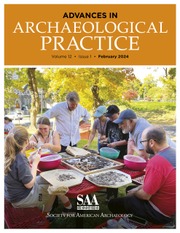No CrossRef data available.
Article contents
Landscape Histories and the Search for Early Settlements along Louisiana's Bayous
Published online by Cambridge University Press: 08 November 2024
Abstract
Historical changes from shifting land use, the natural meandering of waterways, and the aftereffects of erosion complicate modern environments and obfuscate precontact landscapes. Although archaeologists can create stratified sampling models or employ systematic surveys, traditional field methodologies are often not suitable for site discovery, thereby limiting knowledge of ancient cultural landscapes. Many water systems in southern Louisiana, and in many parts of the world, have been covered or concealed in backswamps by natural geomorphological processes, development, or environmental degradation. Investigation standards that do not account for these changes will not be effective at identifying archaeological sites in such transformed landscapes. Discoveries made during ongoing archaeological research in Iberville Parish, Louisiana, provide examples of what can be missed and offer solutions through changes in archaeological field methods. This article advocates for a mixed-methodology approach, drawing from historical research and shallow geophysics to look at landforms and landscape changes. Strictly following state survey guidelines can muddle the archaeological record, particularly in places subject to significant landscape change from historical land-use alteration. By applying these approaches, we offer a way to reconstruct ancient landscapes and landforms that are culturally significant but often missed given the nature of modern environmental conditions.
Resumen
Los cambios históricos derivados del cambio de uso de la tierra, los meandros naturales de los cursos de agua y las secuelas de la erosión complican los entornos modernos y confunden los paisajes culturales prehistóricos. Aunque los arqueólogos pueden crear modelos de muestreo estratificados o emplear estudios sistemáticos, las metodologías de campo tradicionales a menudo no son adecuadas para el descubrimiento de sitios, lo que limita el conocimiento de los paisajes culturales antiguos. Muchos sistemas de agua en el sur de Luisiana, y en muchas partes del mundo, han quedado cubiertos o ocultos en pantanos debido a procesos geomorfológicos naturales, desarrollo, o degradación ambiental. Los estándares de investigación que no toman en cuenta estos cambios no serán eficaces para identificar sitios arqueológicos en paisajes tan transformados. Hallazgos realizados durante investigaciónes arqueológicas en Iberville Parish, Luisiana, proporcionan ejemplos de lo que sepuede omitiry ofrecen soluciones mediante cambios en los métodos de campo arqueológicos. Este estudio aboga por un enfoque de metodología mixta, basándose en la investigación histórica y la geofísica superficial para observar las formas del relieve y los cambios del paisaje. Siguiendo estrictamente las pautas de los estudios estatales puede confundir el registro arqueológico, particularmente en lugares sujetos a cambios significativos en el paisaje debido a la alteración histórica del uso de la tierra. Al aplicar estos enfoques, ofrecemos una manera de reconstruir paisajes y relieves antiguos que son culturalmente significativos pero que a menudo se pasan por alto dada las condiciones ambientales modernas.
Keywords
- Type
- How to Series
- Information
- Advances in Archaeological Practice , Volume 12 , Special Issue 3: Monitoring Heritage at Risk Sites in Rapidly Changing Coastal Environments , August 2024 , pp. 259 - 275
- Copyright
- Copyright © The Author(s), 2024. Published by Cambridge University Press on behalf of Society for American Archaeology


